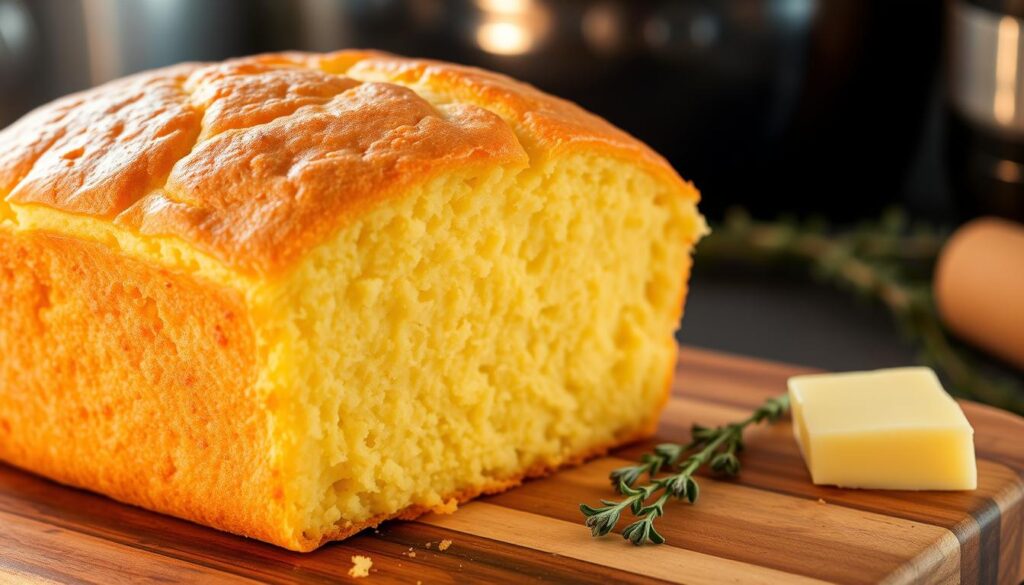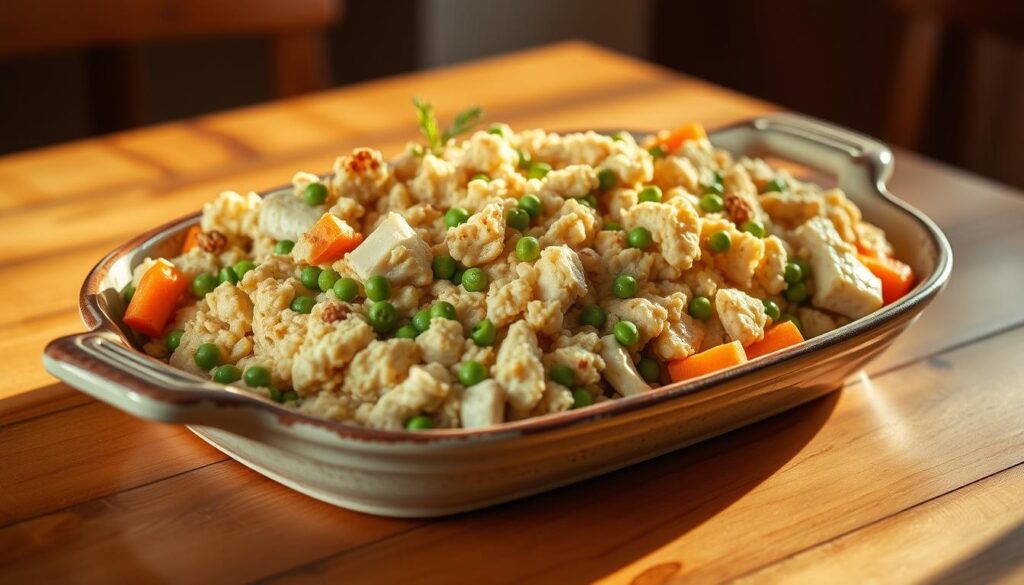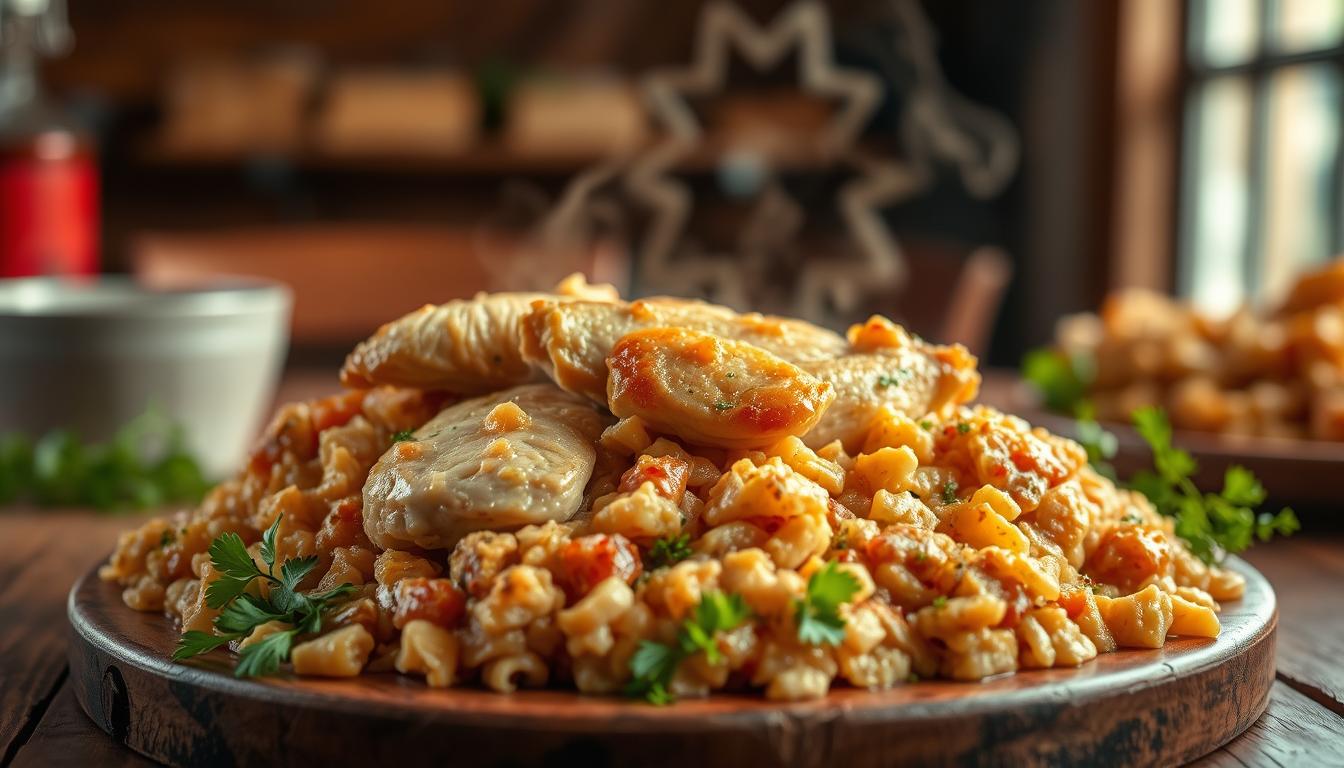Dive into the world of classic Southern cuisine with an authentic homemade chicken and dressing recipe that will transform your kitchen into a culinary haven. This traditional dish represents more than just a meal—it’s a celebration of family, heritage, and incredible flavor that has been passed down through generations.
Southern chicken dressing is a comfort food that speaks directly to the heart of home cooking. Whether you’re preparing a festive holiday meal or craving a hearty weeknight dinner, this recipe will guide you through creating a mouthwatering dish that captures the essence of Southern cooking traditions.
Get ready to explore every nuanced detail of crafting the perfect homemade chicken and dressing. From selecting premium ingredients to mastering cooking techniques, you’ll discover how to create a memorable meal that will have your family asking for seconds.
Key Takeaways
- Learn authentic Southern cooking techniques
- Master the art of creating perfect chicken dressing
- Understand essential ingredients and preparation methods
- Explore traditional Southern culinary heritage
- Create a delicious meal that connects generations
Understanding the Perfect Homemade Chicken and Dressing
Southern cuisine is a treasure trove of culinary traditions, and traditional chicken dressing stands as a beloved centerpiece of family gatherings. This iconic dish represents more than just a side – it’s a cultural experience that connects generations through flavor and comfort.
The roots of southern chicken dressing run deep in American cooking history. What began as a practical way to use leftover bread and poultry transformed into a cherished recipe passed down through family cookbooks and oral traditions.
Exploring Southern Culinary Heritage
Traditional chicken dressing emerged from resourceful home cooks who understood the art of creating delicious meals from simple ingredients. Rural kitchens in the Deep South perfected recipes that transformed humble components into remarkable dishes that could feed large families.
Essential Components Defined
A classic southern chicken dressing typically includes cornbread, chicken, herbs, and seasonings. The key is balancing moisture with texture, creating a dish that’s both rich and light. Your dressing should hold together without becoming dense or dry.
Dressing vs. Stuffing: Understanding the Difference
“Dressing is cooked in a separate pan, while stuffing goes inside the bird – that’s the Southern way of distinguishing these beloved side dishes.”
While many use these terms interchangeably, true Southern cooks know the subtle yet important distinctions. Dressing allows for more controlled cooking and typically features a crispier top that adds wonderful texture to your meal.
Essential Ingredients for Your Chicken Dressing Recipe
Creating an authentic chicken dressing recipe starts with selecting the right ingredients. Your homemade dressing mix will define the flavor and texture of this classic Southern dish. The foundation begins with high-quality bread – traditionally cornbread or a combination of white bread and cornbread.
Chicken stock serves as a critical liquid component in your dressing. Fresh stock provides deeper flavor compared to store-bought versions. Eggs act as a binding agent, helping your homemade dressing mix hold together perfectly. Fresh herbs like sage, thyme, and parsley will elevate the taste profile significantly.
“The secret to an exceptional chicken dressing recipe is using fresh, high-quality ingredients.” – Southern Cooking Experts
Onions and celery create aromatic depth in your dressing. Opt for yellow onions and fresh celery for the best results. Salt, black pepper, and poultry seasoning help balance the flavors. Consider adding chopped giblets for traditional Southern-style texture and richness.
Your homemade dressing mix allows flexibility to adjust seasonings to personal preference. Fresh ingredients make all the difference in transforming a simple chicken dressing recipe into a memorable culinary experience.
Preparing the Perfect Cornbread Base
Creating an exceptional homemade cornbread dressing starts with mastering the foundational ingredient: cornbread. The right cornbread can transform your easy homemade dressing from ordinary to extraordinary.

Your cornbread serves as the critical backbone of a delicious dressing recipe. Traditional Southern cooks know that cornbread isn’t just a side dish—it’s the heart of a perfect dressing.
Cornbread Making Tips
When preparing cornbread for your dressing, choose a cast-iron skillet for the best results. Cast-iron creates a crispy exterior while maintaining a moist interior. Use stone-ground cornmeal for authentic flavor and texture.
Proper Cornbread Texture
The ideal cornbread for homemade cornbread dressing should be slightly dry and crumbly. You want a texture that absorbs seasonings without becoming mushy. Avoid adding too much liquid during the initial baking process.
Aging Your Cornbread
“A day-old cornbread is a dressing’s best friend.” – Southern Cooking Tradition
Let your cornbread sit out overnight to develop a drier consistency. This aging process helps your easy homemade dressing achieve the perfect crumbly texture that absorbs flavors beautifully.
Cooking the Chicken for Your Dressing
Selecting the right chicken is crucial when creating the best chicken and dressing recipe. Your choice of meat can dramatically impact the overall flavor and texture of your homemade dressing for chicken. Professional chefs recommend using bone-in, skin-on chicken for maximum flavor and moisture.
“The secret to an exceptional dressing is in the quality of your chicken preparation.” – Southern Cooking Experts
For the most delicious results, consider roasting your chicken before incorporating it into the dressing. Roasting helps develop deep, rich flavors that will elevate your dish. Start by seasoning the chicken with salt, pepper, and your favorite herbs. Roast at 425°F until the internal temperature reaches 165°F, ensuring both safety and optimal taste.
If you’re short on time, rotisserie chicken works wonderfully in homemade dressing. These pre-cooked birds are already seasoned and tender, making them a convenient option for home cooks. Simply shred the meat into bite-sized pieces, ensuring an even distribution throughout your dressing mixture.
Remember that moisture is key in creating a tender, flavorful dressing. Avoid overcooking the chicken, as this can lead to dry, tough meat. Let the chicken rest before shredding to help retain its natural juices, which will contribute to a more succulent final dish.
Creating the Perfect Seasoning Blend
Crafting an exceptional homemade dressing mix starts with understanding the art of seasoning. Your traditional chicken dressing relies on a carefully balanced blend of herbs and spices that transform an ordinary dish into a culinary masterpiece.
Fresh Herbs: A Flavor Explosion
Fresh herbs can elevate your traditional chicken dressing with vibrant, intense flavors. Sage, thyme, and rosemary bring authentic Southern cooking notes to your homemade dressing mix. Chop these herbs just before mixing to preserve their essential oils and maximize their aromatic potential.
“The difference between good and great dressing is often in the herbs you choose.” – Southern Cooking Tradition
Regional Seasoning Variations
Different regions across the United States feature unique seasoning approaches. Southern recipes might lean towards sage-heavy blends, while Southwestern styles incorporate more robust, spicy elements. Your homemade dressing mix can reflect these regional nuances by experimenting with local herb combinations.
Pro tip: Dried herbs work wonderfully when fresh options aren’t available. They concentrate flavors and provide consistent seasoning throughout your traditional chicken dressing.
Step-by-Step Mixing Process
Creating an easy homemade dressing requires careful attention to mixing techniques. Start by crumbling your prepared cornbread into a large mixing bowl. The texture should be coarse but not too fine, allowing for a perfect chicken dressing recipe consistency.
Next, add your cooked and chopped chicken to the cornbread base. Gently fold the meat into the mixture, ensuring even distribution. This step is crucial for creating a balanced flavor profile in your dressing.
“The secret to an amazing dressing is in the careful mixing of ingredients.” – Southern Cooking Tradition
Slowly incorporate your prepared chicken broth, stirring carefully. You’ll want to achieve a moist but not soggy consistency. Use a light touch when mixing to prevent compacting the ingredients, which can result in a dense dressing.
Add your seasoning blend gradually, tasting as you go. This approach helps you control the flavor intensity of your easy homemade dressing. Remember that the ingredients should complement each other without overwhelming the natural flavors of the chicken and cornbread.
Your final mixture should be slightly wet but not runny. If it seems too dry, add a bit more broth. If too liquid, sprinkle in some additional cornbread crumbs. The goal is a perfect balance that will create a tender, flavorful chicken dressing recipe everyone will love.
Baking Techniques for Moist Dressing
Creating the best chicken and dressing recipe requires mastering the art of baking. Your homemade chicken and dressing can transform from ordinary to extraordinary with the right techniques. The secret lies in understanding how to control temperature and manage moisture during the baking process.
When preparing your homemade chicken and dressing, the baking stage is critical. Professional chefs know that temperature control can make or break your dish. You’ll want to start by preheating your oven to the right temperature – typically around 350°F (175°C) – which helps ensure even cooking without drying out the dressing.
Smart Temperature Management
The key to maintaining moisture is careful temperature monitoring. Cover your baking dish with aluminum foil for the first part of cooking. This traps steam and prevents the top from becoming too crisp too quickly. Uncover during the last 15-20 minutes to allow the surface to develop a golden-brown crust that adds delightful texture to your best chicken and dressing recipe.
Moisture Preservation Techniques
Keeping your dressing moist requires strategic preparation. Before baking, consider adding a bit of chicken broth or stock to your mixture. This extra liquid helps prevent the dressing from becoming dry and crumbly. Check the dish periodically during baking, and if it seems to be drying out, you can add a small amount of additional broth to maintain perfect moisture.
“The difference between good and great dressing is all in the baking technique.” – Southern Cooking Wisdom
Storing and Reheating Your Homemade Dressing
Your delicious homemade chicken and dressing deserves proper care after cooking. Storing southern chicken dressing correctly helps maintain its incredible flavor and texture for multiple days. The key is understanding the right preservation techniques that keep your dish tasting fresh and delectable.
Refrigeration is your first strategy for keeping homemade chicken and dressing safe. Always cool the dressing to room temperature before storing. Transfer the dish to an airtight container and place it in the refrigerator within two hours of cooking. Your southern chicken dressing will stay fresh for 3-4 days when stored properly.
“Great dressing is not just about the initial cooking, but how you preserve its deliciousness afterward.” – Southern Cooking Experts
Freezing offers an excellent option for longer-term storage. Wrap your dressing tightly in freezer-safe containers or heavy-duty aluminum foil. Most homemade chicken and dressing can be frozen for up to one month without losing quality. When you’re ready to enjoy it again, thaw in the refrigerator overnight.
Reheating requires gentle treatment. Preheat your oven to 350°F and cover the dressing with aluminum foil to prevent drying. Warm for 20-30 minutes, adding a splash of chicken broth if needed to maintain moisture. This method ensures your southern chicken dressing remains as delicious as the day you made it.
Serving Suggestions and Side Dishes
Your traditional chicken dressing deserves a spotlight on the dinner table. The right accompaniments can transform your southern chicken dressing from a simple side dish to a memorable culinary experience.

Classic holiday meals often feature traditional chicken dressing alongside a variety of complementary dishes. The key is balancing flavors and textures that enhance your carefully prepared southern chicken dressing.
Classic Southern Companions
Roasted turkey or glazed ham make perfect protein partners for your dressing. Cranberry sauce adds a tangy contrast, while green bean casserole provides a creamy vegetable option. Sweet potato casserole with its caramelized marshmallow topping brings a delightful sweetness that pairs beautifully with savory dressing.
“A well-prepared dressing is the heart of any Southern holiday meal.” – Southern Cooking Traditions
Modern Culinary Pairings
Contemporary home cooks are reimagining traditional chicken dressing with innovative side dishes. Roasted Brussels sprouts with balsamic glaze, quinoa salads, or even a light arugula with citrus vinaigrette can provide fresh, unexpected companions to your classic dressing.
Remember that presentation matters. Serve your southern chicken dressing in a beautiful ceramic dish, garnished with fresh herbs like sage or thyme to elevate the visual appeal of your meal.
Conclusion
Crafting the perfect homemade chicken and dressing is an art that combines tradition, skill, and personal touch. You’ve now explored the intricate steps to create a Southern classic that will impress family and friends. The journey from selecting quality ingredients to perfecting your seasoning blend demonstrates how an easy homemade dressing can become a culinary masterpiece.
Your newfound knowledge of homemade chicken and dressing goes beyond just following a recipe. It’s about understanding the nuanced techniques that transform simple ingredients into a memorable dish. Each step you’ve learned – from preparing the cornbread base to managing moisture during baking – contributes to creating a truly exceptional meal.
Want to share your culinary creations and find more inspiring recipes? Visit luyarecipes.com for additional cooking tips and variations. You can also connect with our cooking community on Pinterest at pinterest.com/luyarecipes/, where home cooks share their favorite Southern-inspired dishes and techniques.
Remember, the most important ingredient in any recipe is the love and passion you bring to the kitchen. Your homemade chicken and dressing will not just be a meal, but a celebration of cooking traditions that bring people together.
FAQ
What is the difference between dressing and stuffing?
In Southern cooking, dressing is typically prepared in a separate baking dish, while stuffing is cooked inside the cavity of a turkey or chicken. Dressing is usually made with cornbread as a base, whereas stuffing can be made with various types of bread. The key distinction is that dressing is baked separately, allowing it to develop a crispy top and more defined texture.
Can I make chicken and dressing ahead of time?
Absolutely! You can prepare chicken and dressing up to 2-3 days in advance. Store it covered in the refrigerator and reheat in the oven at 350°F for about 20-25 minutes. For best results, add a little chicken broth before reheating to maintain moisture. You can also freeze the dressing for up to 3 months, making it a great make-ahead holiday dish.
What type of bread works best for chicken dressing?
Cornbread is the traditional base for Southern chicken dressing. Use a day-old, slightly dried cornbread for the best texture. You can also mix in some white bread or biscuits for added complexity. The key is to use day-old or slightly stale bread to help the dressing absorb the liquid ingredients without becoming too soggy.
How do I keep my dressing from becoming too dry?
To prevent dry dressing, use plenty of chicken broth or stock when mixing your ingredients. Cover the dressing with foil while baking for the first part of the cooking process, then uncover for the last 15-20 minutes to create a crispy top. Adding extra broth just before baking and checking the moisture level periodically can help maintain a moist, tender dressing.
Can I make this recipe gluten-free?
Yes, you can create a gluten-free version of chicken and dressing. Use gluten-free cornbread or gluten-free bread as your base. Ensure all other ingredients like chicken broth and seasonings are certified gluten-free. Replace regular flour with a gluten-free alternative if your recipe calls for thickening agents.
What herbs work best in chicken dressing?
Traditional Southern dressing typically uses sage, thyme, and parsley. Fresh herbs can provide a more vibrant flavor, but dried herbs work well too. Sage is particularly important in creating that classic dressing taste. You can adjust the herb blend to suit your personal preference, but these herbs form the traditional flavor profile.
How long can I store leftover chicken and dressing?
Leftover chicken and dressing can be stored in an airtight container in the refrigerator for 3-4 days. Always ensure you refrigerate the dish within two hours of cooking. When reheating, make sure the internal temperature reaches 165°F to ensure food safety. For best quality, consume within 3 days of preparation.
Can I use rotisserie chicken for this recipe?
Rotisserie chicken is an excellent time-saving option for chicken and dressing. It provides pre-cooked, flavorful meat that can easily be shredded and incorporated into your dressing. Just be mindful of the salt content, as rotisserie chickens are often pre-seasoned, and you may need to adjust your additional seasoning accordingly.









